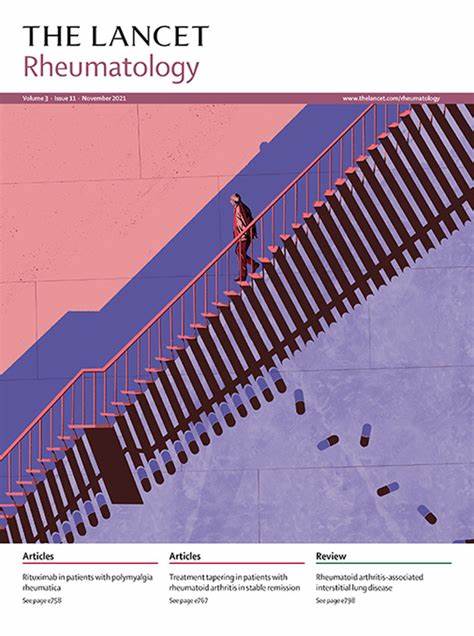疾病相关脑激活预测类风湿关节炎患者对TNF抑制的临床反应(precpra):一项随机、多中心、双盲、安慰剂对照的3期研究。
IF 16.4
1区 医学
Q1 RHEUMATOLOGY
引用次数: 0
摘要
背景:类风湿关节炎是一种炎性疾病,常用TNF抑制剂治疗。对TNF抑制剂反应的预测因子知之甚少。由于类风湿关节炎的临床反应是通过包含主观患者导向域(例如疼痛和整体疾病感知)的综合评分来衡量的,因此我们假设中枢神经系统疾病代表性高的患者可能比中枢神经系统疾病代表性低的患者对TNF抑制剂的反应更好。方法:我们在德国、葡萄牙和塞尔维亚的六个风湿病中心对活动性类风湿关节炎患者进行了一项3期、多中心、双盲、安慰剂对照、平行组随机试验。所有患者在基线时进行功能性磁共振成像(fMRI)脑部扫描以测量中枢神经系统疼痛激活。患者(年龄≥18年)活动性类风湿性关节炎有活动性疾病尽管使用至少一个传统合成疾病修饰治疗风湿病的药物是分层fMRI体积体积(高或低)和被随机分配2:1使用一个随机生成的列表统计学家研究与肿瘤坏死因子抑制剂治疗certolizumab pegol (400 mg皮下周0、2和4,和200毫克每隔两周最大24周)或安慰剂。患者和临床医生被蒙面分配。主要终点是在意向治疗人群中,在第12周达到低疾病活动度(28个关节疾病活动度评分≤3.2)的患者比例。研究设计中不涉及生活经验。该研究已在EudraCT(2013-000337-13)和ClinicalTrials.gov (NCT01864265)注册。研究结果:在2013年9月3日至2020年1月10日期间,筛选了148例类风湿性关节炎患者,其中139例(99例[71%]女性和40例[29%]男性)被随机分配到大剂量certolizumab pegol组(n=49)、小剂量certolizumab pegol组(n=43)或安慰剂组(n=47)。在第12周,大剂量certolizumab pegol组有28人(57%)达到低疾病活动性,小剂量certolizumab pegol组有19人(44%),安慰剂组有12人(26%)达到低疾病活动性。大剂量certolizumab pegol组的疗效与安慰剂组有显著差异(p= 0.0017),而小剂量certolizumab pegol组无显著差异(p= 0.063)。有25例治疗相关不良事件:certolizumab pegol组22例,安慰剂组3例。解释:高疾病相关fMRI CNS疼痛激活可能预测类风湿关节炎患者对TNF抑制剂治疗的临床反应。资助:UCB Biopharma。本文章由计算机程序翻译,如有差异,请以英文原文为准。
Disease-associated brain activation predicts clinical response to TNF inhibition in rheumatoid arthritis (PreCePra): a randomised, multicentre, double-blind, placebo-controlled phase 3 study
Background
Rheumatoid arthritis is an inflammatory disease frequently treated with TNF inhibitors. Little is known about predictors of response to TNF inhibitors. Because clinical response in rheumatoid arthritis is measured by composite scores containing subjective patient-orientated domains (eg, pain and global disease perception), we hypothesised that patients with high disease representation in the CNS might respond better to TNF inhibitors than patients with less CNS disease representation.
Methods
We did a phase 3, multicentre, double-blind, placebo-controlled, parallel-group randomised trial in patients with active rheumatoid arthritis at six rheumatology centres across Germany, Portugal, and Serbia. All patients had a functional MRI (fMRI) brain scan at baseline to measure CNS pain activation. Patients (aged ≥18 years) with active rheumatoid arthritis who have active disease despite the use of at least one conventional synthetic disease-modifying antirheumatic drug were stratified according to fMRI (high volume or low volume) and were randomly assigned 2:1 using a randomisation list generated by a study statistician to treatment with the TNF inhibitor certolizumab pegol (400 mg subcutaneously on weeks 0, 2, and 4, and 200 mg once every 2 weeks for maximum 24 weeks) or placebo. Patients and clinicians were masked to allocation. The primary outcome was the proportion of patients reaching low disease activity (Disease Activity Score in 28 joints ≤3·2) at week 12, analysed in the intention-to-treat population. There was no lived experience involvement in study design. The study was registered with EudraCT (2013-000337-13) and ClinicalTrials.gov (NCT01864265).
Findings
Between Sept 3, 2013, and Jan 10, 2020, 148 patients with rheumatoid arthritis were screened and 139 (99 [71%] women and 40 [29%] men) were randomly assigned to the high-volume certolizumab pegol group (n=49), the low-volume certolizumab pegol group (n=43), or the placebo group (n=47). Low disease activity was reached by 28 (57%) in the high-volume certolizumab pegol group, 19 (44%) in the low-volume certolizumab pegol group, and 12 (26%) in the placebo group at week 12. Response in the high-volume certolizumab pegol group was significantly different (p=0·0017) to the placebo group, but not the low-volume certolizumab pegol group (p=0·063). There were 25 treatment-related adverse events: 22 in the certolizumab pegol groups and three in the placebo group.
Interpretation
High disease-associated fMRI CNS pain activation might predict clinical response of patients with rheumatoid arthritis to TNF inhibitor treatment.
Funding
UCB Biopharma.
求助全文
通过发布文献求助,成功后即可免费获取论文全文。
去求助
来源期刊

Lancet Rheumatology
RHEUMATOLOGY-
CiteScore
34.70
自引率
3.10%
发文量
279
期刊介绍:
The Lancet Rheumatology, an independent journal, is dedicated to publishing content relevant to rheumatology specialists worldwide. It focuses on studies that advance clinical practice, challenge existing norms, and advocate for changes in health policy. The journal covers clinical research, particularly clinical trials, expert reviews, and thought-provoking commentary on the diagnosis, classification, management, and prevention of rheumatic diseases, including arthritis, musculoskeletal disorders, connective tissue diseases, and immune system disorders. Additionally, it publishes high-quality translational studies supported by robust clinical data, prioritizing those that identify potential new therapeutic targets, advance precision medicine efforts, or directly contribute to future clinical trials.
With its strong clinical orientation, The Lancet Rheumatology serves as an independent voice for the rheumatology community, advocating strongly for the enhancement of patients' lives affected by rheumatic diseases worldwide.
 求助内容:
求助内容: 应助结果提醒方式:
应助结果提醒方式:


